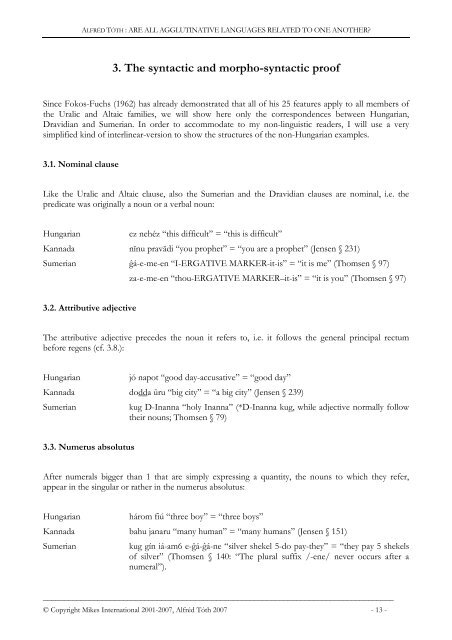Are all agglutinative languages related to one another?
Are all agglutinative languages related to one another?
Are all agglutinative languages related to one another?
You also want an ePaper? Increase the reach of your titles
YUMPU automatically turns print PDFs into web optimized ePapers that Google loves.
ALFRÉD TÓTH : ARE ALL AGGLUTINATIVE LANGUAGES RELATED TO ONE ANOTHER?<br />
3. The syntactic and morpho-syntactic proof<br />
Since Fokos-Fuchs (1962) has already demonstrated that <strong>all</strong> of his 25 features apply <strong>to</strong> <strong>all</strong> members of<br />
the Uralic and Altaic families, we will show here only the correspondences between Hungarian,<br />
Dravidian and Sumerian. In order <strong>to</strong> accommodate <strong>to</strong> my non-linguistic readers, I will use a very<br />
simplified kind of interlinear-version <strong>to</strong> show the structures of the non-Hungarian examples.<br />
3.1. Nominal clause<br />
Like the Uralic and Altaic clause, also the Sumerian and the Dravidian clauses are nominal, i.e. the<br />
predicate was origin<strong>all</strong>y a noun or a verbal noun:<br />
Hungarian ez nehéz “this difficult” = “this is difficult”<br />
Kannada nīnu pravādi “you prophet” = “you are a prophet” (Jensen § 231)<br />
Sumerian ĝá-e-me-en “I-ERGATIVE MARKER-it-is” = “it is me” (Thomsen § 97)<br />
3.2. Attributive adjective<br />
za-e-me-en “thou-ERGATIVE MARKER–it-is” = “it is you” (Thomsen § 97)<br />
The attributive adjective precedes the noun it refers <strong>to</strong>, i.e. it follows the general principal rectum<br />
before regens (cf. 3.8.):<br />
Hungarian jó napot “good day-accusative” = “good day”<br />
Kannada dodda ūru “big city” = “a big city” (Jensen § 239)<br />
Sumerian kug D-Inanna “holy Inanna” (*D-Inanna kug, while adjective norm<strong>all</strong>y follow<br />
their nouns; Thomsen § 79)<br />
3.3. Numerus absolutus<br />
After numerals bigger than 1 that are simply expressing a quantity, the nouns <strong>to</strong> which they refer,<br />
appear in the singular or rather in the numerus absolutus:<br />
Hungarian három fiú “three boy” = “three boys”<br />
Kannada bahu janaru “many human” = “many humans” (Jensen § 151)<br />
Sumerian kug gín iá-am6 e-ĝá-ĝá-ne “silver shekel 5-do pay-they” = “they pay 5 shekels<br />
of silver” (Thomsen § 140: “The plural suffix /-ene/ never occurs after a<br />
numeral”).<br />
___________________________________________________________________________________<br />
© Copyright Mikes International 2001-2007, Alfréd Tóth 2007 - 13 -

















